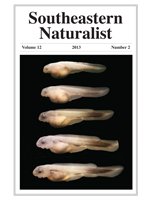We captured and radio-marked 64 Dryocopus pileatus (Pileated Woodpecker) in bottomland hardwood forests from February 2007 to June 2010. At least 12 (35.3%) of the first 34 birds radio-tagged died within 43 d of capture ( = 8.2 d). Thus, we adjusted our radio-attachment techniques adaptively from a figure-eight harness to a tail-mount, and reduced handling times to minimize stress on woodpeckers. In 2009 and 2010, after the change in attachment type and modified handling protocol including a reduction of handling time (from ca. 1 h to 30 min), all 30 radio-marked birds (100%) survived the entire field season (≥3 mo). These data suggested that Pileated Woodpeckers, and perhaps other large woodpeckers, have an increased risk of death when tagged with figure eight harnesses, handled for longer periods and more obtrusively, and captured on days with relatively cold temperatures. We submit that future telemetry on this species or other large woodpeckers should not employ the figure-eight harnesses and should strive to minimize handling time and disturbance. We recommend that other ornithologists observing higher than expected mortalities possibly related to handling birds or transmitter attachment publish this information to minimize the adverse impacts on birds during future research.
= 8.2 d). Thus, we adjusted our radio-attachment techniques adaptively from a figure-eight harness to a tail-mount, and reduced handling times to minimize stress on woodpeckers. In 2009 and 2010, after the change in attachment type and modified handling protocol including a reduction of handling time (from ca. 1 h to 30 min), all 30 radio-marked birds (100%) survived the entire field season (≥3 mo). These data suggested that Pileated Woodpeckers, and perhaps other large woodpeckers, have an increased risk of death when tagged with figure eight harnesses, handled for longer periods and more obtrusively, and captured on days with relatively cold temperatures. We submit that future telemetry on this species or other large woodpeckers should not employ the figure-eight harnesses and should strive to minimize handling time and disturbance. We recommend that other ornithologists observing higher than expected mortalities possibly related to handling birds or transmitter attachment publish this information to minimize the adverse impacts on birds during future research.
How to translate text using browser tools
1 June 2013
Effects of Radio-Transmitter Methods on Pileated Woodpeckers: An Improved Technique for Large Woodpeckers
Brandon L. Noel,
James C. Bednarz,
Mark G. Ruder,
M. Kevin Keel
ACCESS THE FULL ARTICLE

Southeastern Naturalist
Vol. 12 • No. 2
June 2013
Vol. 12 • No. 2
June 2013




